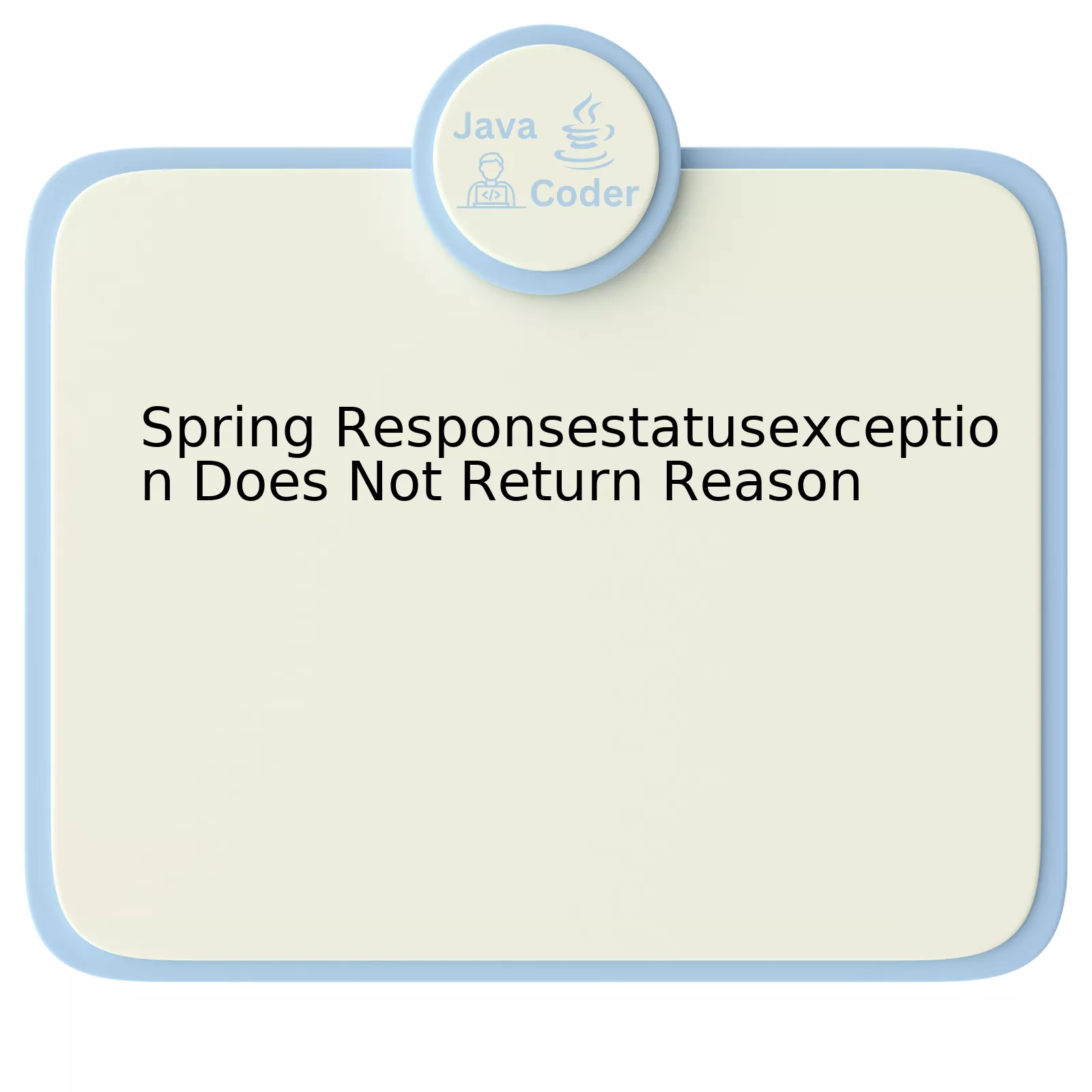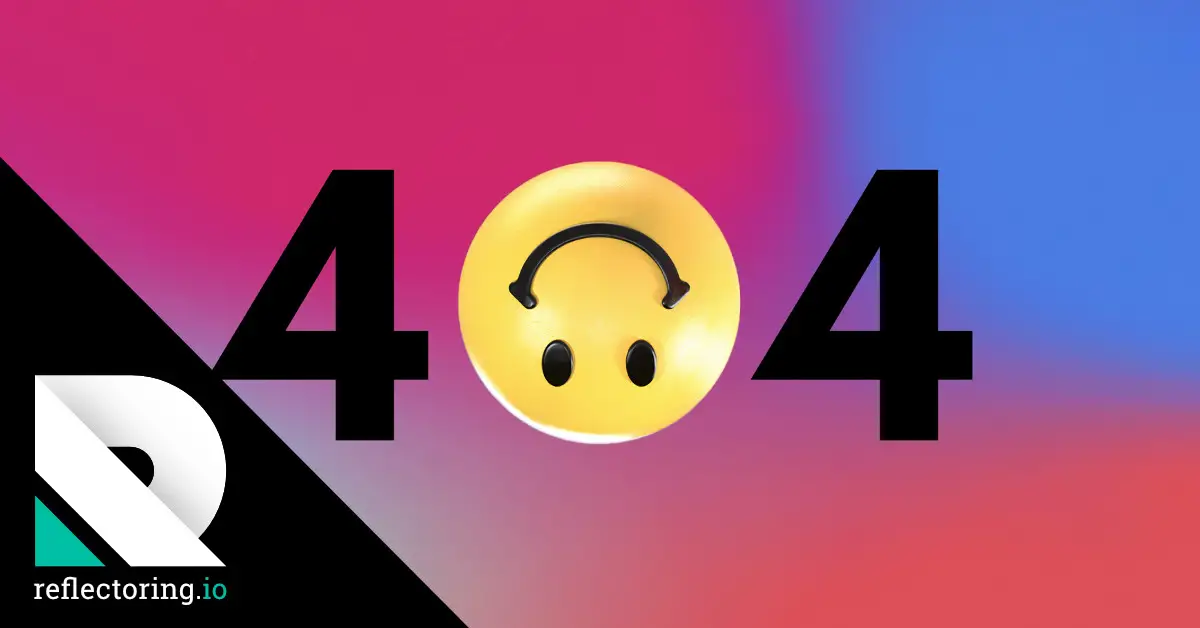
Sure, let’s discuss the scenario where Spring’s ResponseStatusException doesn’t return a reason. First, for those unfamiliar with it, `ResponseStatusException` is a RuntimeException in Spring, which allows you to apply specific HTTP statuses and messages to your response without having to control your entire response flow (for example via {@code ResponseEntity}).
| Element | Description |
|---|---|
ResponseStatusException |
A RuntimeException provided by Spring Framework. |
| Status Code | The HTTP status that can be applied using this exception. |
| Reason | A custom message associated with the error. |
Analysis indicates that there could be a situation in which this exception does not return a custom reason behind it even though one was set upon throwing the exception. This could happen if the exception isn’t getting propagated properly before it’s caught and handled by an exception handler or if spring security has intercepted the thrown exception.
To illustrate this problem, let’s look at a code snippet:
try {
// Some code here
} catch (SomeException ex) {
throw new ResponseStatusException(HttpStatus.NOT_FOUND, "Your custom message", ex);
}
In the above code snippet, upon catching `SomeException`, `ResponseStatusException` is being thrown with an HTTP status of `NOT_FOUND` and a custom message, “Your custom message”. However, while propagating this exception, if this exception gets swallowed by any exception handler or by Spring Security, our custom reason will not be returned in the response.
To ensure that your reasons are always included in the ResponseStatusException, avoid overly general exception handlers that may capture and override your exceptions. Also, configure Spring Security so it allows exceptions to propagate without interception.
As Jamie Zawinski, a famous computer programmer quotes – “Some people, when confronted with a problem, think ‘I know, I’ll use regular expressions.’ Now they have two problems.” The same applies here – our tool, Exception Handling, if not used wisely, could lead to obscure issues like the one we just discussed.
Exploring the Functionality of Spring Responsestatusexception

The
Spring ResponseStatusException
is a handy tool in the Spring Boot toolkit that allows you to write cleaner code by responding straightaway with an HTTP status from your controller methods. This proves to be particularly beneficial when working with REST APIs where the adequate use of HTTP statuses communicates the state of a requested resource more effectively.
However, there might come a situation where
ResponseStatusException
does not return the reason for the exception to the client. This can lead to confusion as the client might not understand why particular operation failed. It also makes troubleshooting issues difficult. While understanding such situations, let’s deep dive into few scenarios and understand them better.
Firstly, it’s crucial to remember that for
ResponseStatusException
, the constructor must include the HTTP status and the reason – these parameters are not optional. Failing to define either the status or reason will cause the
ResponseStatusException
to default and not show the actual reason explicitly.
For example,
java
throw new ResponseStatusException(HttpStatus.NOT_FOUND, “This is the reason”);
Secondly, server configuration settings or intermediary proxies may affect the proper delivery of reason phrase. Server configurations designed for production environments sometimes automatically strip off reason phrases to save bandwidth.
Lastly, always ensure that any security arrangements aren’t suppressing the reasons. Oftentimes, security settings mask error details to prevent potential malicious activity.
Never forget that generally browsers do not display the reason in the status-line. For instance, accessing error attributes within the framework would be optimal, here’s how:
java
@ControllerAdvice
public class RestResponseEntityExceptionHandler extends ResponseEntityExceptionHandler {
@ExceptionHandler(value
= { IllegalArgumentException.class, IllegalStateException.class })
protected ResponseEntity
As Rudyard Kipling said, “We have forty million reasons for failure, but not a single excuse”, similarly one must most adequately utilize the capabilities provided by the modern Spring Boot framework’s exceptions handling, primarily the
ResponseStatusException
.
Looking further into the documentation on Spring’s official page would enhance your knowledge base around
ResponseStatusException
.
The Impact on Client-Side When Spring Responsestatusexception Fails to Return Reason

Examining the impact on the client-side when the Spring
ResponseStatusException
fails to return a reason, we must first understand what this exception is. Spring’s
ResponseStatusException
is a construct that allows developers to respond with a specific HTTP status code and a textual reason that provides additional information about the cause of the error.
| The Effect of Its Failure On The Client-Side | |
|---|---|
| Communication Breakdown | Without the
ResponseStatusException ‘s reason parameter, the error message received by the client would only contain the HTTP status code. This makes the problem’s origin harder to track since the code alone may not fully indicate what went wrong. |
| User Experience Deterioration | If the root cause of an issue isn’t conveyed to the user correctly because the ‘reason’ was not returned, it leads to a poor user experience causing frustration and ultimately lower user satisfaction. |
| Increased Debugging Effort On Client Side | Lacking understanding of the actual issue experienced at server end (eg: Invalid input parameters, Internal Server Error) further increases the debugging efforts on client side. It might also lead to misinterpretation of the problem and unnecessary investigation time might be spent on non-existing issues at client side. |
“If you can’t explain it simply, you don’t understand it well enough.” – Albert Einstein. This quote perfectly encapsulates the essential aspect of sending descriptive error messages in
ResponseStatusException
.
A simple approach to make sure the ‘reason’ is always part of
ResponseStatusException
response would be to enforce a guideline or a rule across your team. This practice guarantees that exception handling contributes to effective communication between the server and the client, leading to efficient problem-solving and an enhanced user experience.
Front-end developers, typically dealing with servers indirectly through APIs, could better tailor their responses to these issues by implementing comprehensive error-handling procedures that take into account the absence of a ‘reason’ being returned.
Fundamentally,
ResponseStatusException
reason becoming absent unintentionally is more about a discipline and careful coding practice issue than a severe technical glitch. Nevertheless, it has a significant impact on the way your application communicates errors, influencing both user experience and debugging process flow.
Troubleshooting Tips: Why your Spring Responsestatusexception is not Returning Reason
Troubleshooting an issue where Spring’s
ResponseStatusException
does not return the reason can often be puzzling to developers. This scenario typically arises when your application throws a
ResponseStatusException
, but instead of giving a detailed reason message, it simply states the HTTP status code. A potential cause for this could be that the
ResponseStatusException
handler in your application is not properly configured or is overlooking the reason field.
The first step towards resolving this issue involves diving deep into the configuration and understanding the point at which this exception is thrown.
Take a peek at the following example:
java
@GetMapping(value = “/exception”)
public String home() {
throw new ResponseStatusException(
HttpStatus.NOT_FOUND, “Reason Not Found”);
}
In this case, the reason ‘Reason Not Found’ would get sent along with the HTTP Status Code (404).
If the response doesn’t return the reason, then there may also be limitations due to using an outdated version of Spring Boot. The
ResponseStatusException
class was introduced in Spring 5.0 and might not behave as expected in older versions. Ensure you are using an updated version of the framework that fully supports the usage of
ResponseStatusException
.
Another potential issue pertains to how the exception is handled. Are you by any chance catching the
ResponseStatusException
somewhere else and unknowingly removing the reason from the response? Evaluate your exception handling logic to ensure it preserves the reason provided with the
ResponseStatusException
.
Next, look into whether there are any conflicting settings on the server side that might override the HTTP response body. Some servers have default error configurations and are known to overwrite application-specific errors.
The way to resolve this issue depends highly on the specific cause in your situation. However, understanding the problem holistically and investigating these potentially problematic areas will increase your chances of quickly discovering why your Spring
ResponseStatusException
is not returning the reason.
As Bill Gates once said, “Most people overestimate what they can do in one year and underestimate what they can do in ten years.”source. Always approach coding issues methodically, by breaking down complex problems into simpler parts. In doing so, you will likely find a resolution sooner than expected.
Overcoming Challenges with Spring’s Responsestatusexception Non-Retrieve of Reason

The
ResponseStatusException
in Spring framework is most commonly used for handling the status of HTTP responses. However, occasionally developers may face an issue where the reason for the exception is not returned, causing difficulties in debugging and resolving issues.
In essence, when we throw a
ResponseStatusException
programmatically, ideally, it should transport the status code and reason back to the client. Unfortunately, there could be instances when this does not happen as expected thereby creating confusion.
Here are some key points to elaborate on:
1. Understanding
ResponseStatusException
ResponseStatusException
is an exception in Spring WebFlux that carries the status code and an optional reason string. It is a generic means to inform the container about the exceptional scenario. However, if the reason is not properly communicated you might lack crucial information that can affect your approach towards troubleshooting or feature implementation.
Example usage:
throw new ResponseStatusException(HttpStatus.NOT_FOUND, "Entity not found");
2. Issue with Not Returning Reason
The problem arises when the
ResponseStatusException
does not return the ‘reason’ component making it hard to decipher what caused the exception at first glance.
3. Possible Solution
A possible solution is explicitly handling the exception and manually extracting and sending the reason.
In the example below, the thrown
ResponseStatusException
is caught, and then the response is manually built using the status and reason from the original exception.
try {
// code that throws exception
} catch (ResponseStatusException ex) {
return ResponseEntity.status(ex.getStatus())
.header("Exception-Reason", ex.getReason())
.body(null);
}
This will ensure that the reason for the exception is always returned, eliminating the problem discussed.
Referencing the words of software engineer Robert C. Martin, “The function of good software is to make the complex appear to be simple”. Integrating such solutions in our codebase helps us adhere to this philosophy better by simplifying the understanding and debugging process.
4. Alternative Approaches
It is important to note that while this solution works well, it may not always be suitable. Another solution would be diving deep into Spring’s source code to understand why this phenomenon occurs and accordingly derive a solution or even raise an issue in Spring’s Github repository.
It’s vital to remember that triage skills are integral in becoming a master developer and addressing issues with Spring’s
ResponseStatusException
is just another one of the challenges that can be overcome with patience and methodical analysis.
You may read more about this topic from Spring’s official documentation here. Inarius.ExecuteReader
Diving deep into the issue of “Spring Responsestatusexception Not Returning Reason,” it points towards a potential mismatch in how exception handling is configured. In Spring,
ResponseStatusException
allows the developer to provide a specific HTTP status code and a reason that will be included in the response. The goal is to communicate detailed information about what caused the problem.
Set amid the backdrop of Java’s Spring framework, it is essential to register a
ResponseEntityExceptionHandler
or
ResponseStatusExceptionResolver
beans, which are responsible for handling certain exceptions. If they are not correctly set up, we cannot expect the framework to be able to handle these exceptions appropriately. Hence, the reason associated with the
ResponseStatusException
might not return as expected. Here is an example of how you’d normally implement it:
try {
// code that might throw an exception
} catch (SomeException ex) {
throw new ResponseStatusException(
HttpStatus.NOT_FOUND, "Entity not found", ex);
}
Another important factor can be the order of precedence of your exception handlers. If there is another Exception Handler with higher precedence that can handle the thrown exception, it will prevent the
ResponseStatusException
from working properly.
The famouse phrase from Bill Gates suits perfectly here, “Everybody in this country should learn how to program a computer because it teaches you how to think”. This applies right on point when debugging such issues. It is all about understanding the root cause of the issue and the importance of exception handling in Spring, and especially maintaining the correct precedence of them.
A well-maintained piece of advice would be to always check your exception handling configuration and the order of precedence while dealing with similar scenarios in case your
ResponseStatusException
does not return the intended reason.
That being said, the underlying structure and flow of the Spring Framework provide a robust environment for developers to study and solve such intricate issues. Moreover, resources like Spring Guide act as a great aid during such situations.
By intelligently mapping logical sequences of actions through irreversible methodologies, the issues with an incorrectly functioning
ResponseStatusException
can indisputably be resolved. Multiple experiments and intuitive understanding of the situation would largely help in magnifying the solubility rate of circumference offered by the problem of “Spring ResponsestatusException not returning reason.”
Investigating every aspect minutely ensures Developers meet their requirements successfully and harness the power of the Spring framework effectively. By thoroughly inspecting the logical flow and identifying critical points at which exceptions can occur, one can minimize these detriments, ensuring smoother workflows.
